
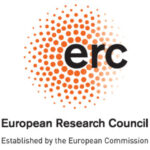
‘Conquering a New Paradigm for Addressing Ion Detection in Real Scenarios’
ERC Starting Grant (Agreement Nr 851957)
€ 1 605 248,75
Starting date: 01.01.2021
Program: H2020-EU.1.1. – EXCELLENT SCIENCE – European Research Council (ERC)
‘The Smaller the Better for Ion detection. ConquerIons is developing pioneering ion sensing concepts using nanomembranes towards next-generation high-performance nanosensors for a variety of applications.’
ConquerIons is seeking a definitive solution for the detection of ions in real scenarios by innovatively addressing the limitations of traditional ion-sensing concepts in terms of effectiveness, sensitiveness, robustness and downscaled platforms. The project combines efforts from the synthetic chemistry, material science, nanoscience, electrochemistry and analytical chemistry disciplines resulting in a universal concept for the reliable detection of ions. ConquerIons is based on a research approach carefully designed mainly considering the following challenges: (i) the use of novel materials to afford a robust and universal detection; (ii) the implementation of thin-layer concepts to achieve reduced limits of detection and calibration-free methodology; (iii) the translation of the developed concepts to the single-entity; and (iv) exploitation of sensors from the laboratory context based on relevant cases as the next step towards the final use as daily smart informers operating in real scenarios. This latter purpose will lead to a series of extraordinary analytical applications from a long-term perspective related to very distinct fields, such as cell-scale therapies and speciation of trace ion levels in environmental analysis.
01.04.2021
On the basis of a well thought out plan, we have now received the raw materials that are needed for the synthesis and preparation of the new elements that the ConquerIons project proposes to build up the new nanosensors for ions.
15.03.2021
The first results are being finalized and packed for publication: Spectroelectrochemistry experiments have provided a nice study about the mechanism behind the response of the sensors to be developed in ConquerIons: ‘Understanding fundaments to be able to build up superior sensors for ions’. PhD student Yujie Liu have conducted the experiments.
25.02.2021
Docent presentation by Asst. Prof. Maria Cuartero “Real World Applications in Electroanalysis: One of the Pillars of the Modern Analytical Chemistry”
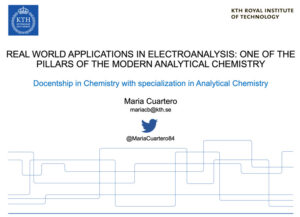
23.02.2021
Nominated by Nominated by @ERC_Research and @snsf_ch to be part of @AcademiaNet_org, the database of excellent female researchers from all disciplines.
15.02.2021
Special Issue «Modern Directions in Ion #Electroanalysis for Real World Applications» guest edited by Prof. Dr. Maria Cuartero is open for submission.
https://www.mdpi.com/journal/chemosensors/special_issues/MDIE
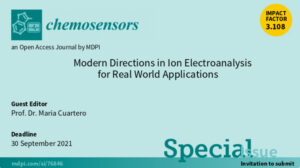
01.02.2021
Building up the ConquerIons team
18.01.2021
Official presentation of the ConquerIons project to the scientific community.
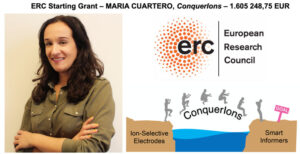
12.01.2021
Kick-off meeting with KTH Research Support Office and Financing Department.
01.01.2021
The ConquerIons project officially starts.
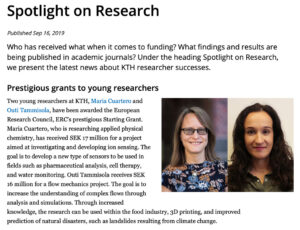
01.02.2021
Understanding fundaments to be able to build up superior sensors for ions
The sensors envisioned by the ConquerIons project are based on interconnected charge-transfer (CT) and ion-transfer (IT) processes confined in the nanoscale domain of an ion-selective membrane. The concept aims at reformulating the traditional working mechanism of all-solid-state ion-selective electrodes (ISEs) operating in potentiometry mode.
Very recently, in our research team, we have discovered that spectroelectrochemistry experiments are suitable to monitor the CT process particularly occurring with all-solid-state ISEs containing POT as the redox material. We take advantage of the absorbance change in the POT film while being oxidized, to monitor the CT linked to different IT happening at the sample–membrane interface. We incorporated from one to three ionophores to promote a change in the nature and number of the ITs. The CT is visualized as an independent sigmoid in different potential ranges corresponding to the assigned IT. In addition, simple calculation of the empirical CT is available by utilizing the mathematical Sigmoidal–Boltzmann model. The identification of the physical meaning of the mathematical definition of the CT opened up new possibilities for the design of sensors with superior analytical features, as those aimed in the ConquerIon project. In addition, the spectroelectrochemistry strategy can be used in combination with different materials and nanosensor structures encompassing the project program.